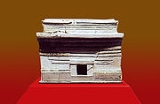
Tarxien phase
Encyclopedia
The Tarxien phase followed the Saflieni phase
(3000-2500 BCE) and typifies the last and most advanced period of temple building in prehistoric Malta
. The Tarxien phase evolved into the Tarxien Cemetery phase
(2500-1500 BCE) and Borġ in-Nadur phase (1400-800 BCE).
 Three main temple structures and the remains of a small fourth were unearthed at the Tarxien complex
Three main temple structures and the remains of a small fourth were unearthed at the Tarxien complex
. All except the last structure to be built, the Central Temple, are sited in a southeast quadrant. With the exception of the Early Temple, which dates back to the older Ġgantija phase
(3600–3200 BCE), the three principal temples date back to the eponymous Tarxien phase, as does part of the Mnajdra complex, and represent the last of the temple structures to be constructed by prehistoric man in Malta.
The Tarxien temples are noted for fine statuary, friezes, reliefs and a wealth of pottery. Animal and spiral motifs are abundant. The originals of the artifacts have been moved to the Archaeological Museum of Valletta for preservation and safekeeping; modern copies take their place on site.
Saflieni phase
The Saflieni phase of Malta's prehistory was named after the Hypogeum of Ħal-Saflieni. The hypogeum and part of the Ta' Ħaġrat temple complex both date from this period....
(3000-2500 BCE) and typifies the last and most advanced period of temple building in prehistoric Malta
Malta
Malta , officially known as the Republic of Malta , is a Southern European country consisting of an archipelago situated in the centre of the Mediterranean, south of Sicily, east of Tunisia and north of Libya, with Gibraltar to the west and Alexandria to the east.Malta covers just over in...
. The Tarxien phase evolved into the Tarxien Cemetery phase
Tarxien Cemetery phase
The transition from the Tarxien phase to the Tarxien Cemetery culture is theorized to have begun circa 2000 BCE. All traces of Malta's temple builders were lost around 1800 BCE...
(2500-1500 BCE) and Borġ in-Nadur phase (1400-800 BCE).
Tarxien Overview

Tarxien Temples
The Tarxien Temples are an archaeological complex in Tarxien, Malta. They date back to approximately 2800 BC. The site was accepted as a UNESCO World Heritage Site in 1980 along with the other Megalithic temples on the island of Malta.-Description:...
. All except the last structure to be built, the Central Temple, are sited in a southeast quadrant. With the exception of the Early Temple, which dates back to the older Ġgantija phase
Ggantija phase
The Ġgantija phase owes its name to the Ġgantija Temples in Xagħra, Gozo. The Ġgantija phase is directly preceded by the Mġarr phase , and is characterized by a change in the way the prehistoric inhabitants of Malta lived...
(3600–3200 BCE), the three principal temples date back to the eponymous Tarxien phase, as does part of the Mnajdra complex, and represent the last of the temple structures to be constructed by prehistoric man in Malta.
The Tarxien temples are noted for fine statuary, friezes, reliefs and a wealth of pottery. Animal and spiral motifs are abundant. The originals of the artifacts have been moved to the Archaeological Museum of Valletta for preservation and safekeeping; modern copies take their place on site.

